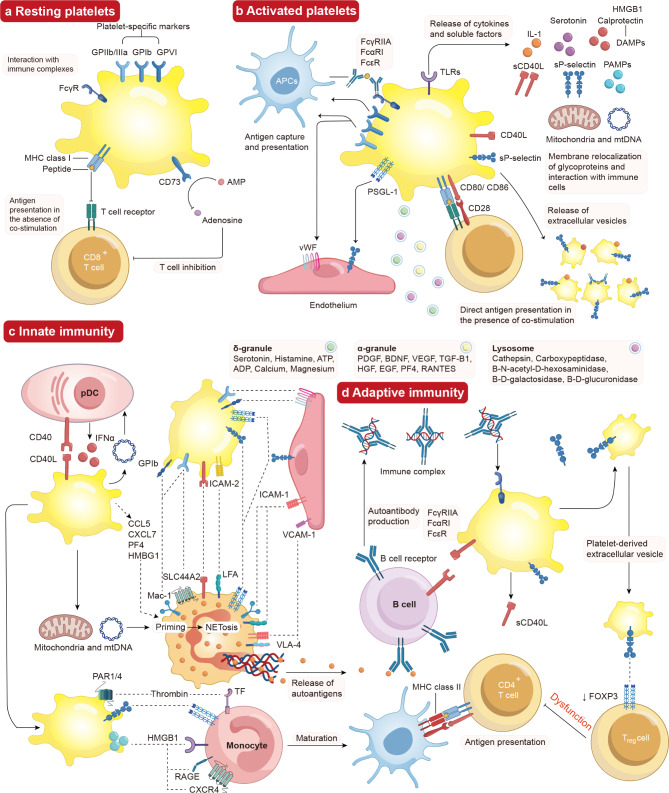Fig. 2.
Effects of interaction between activated platelets and the immune system. (a) Resting Platelet-specific receptors, including the glycoproteins GPIIb/IIIa, GPIb, GPVI, CD73, MHC class I and FcγR are expressed by resting platelets. Resting platelets express MHC Class I in the lack of costimulatory compounds and express ectonucleosidase CD73, which inhibits CD8+ T cells that convert AMP into the anti-inflammatory properties’ adenosine. Resting platelets also express FcγR, which assists in removing circulating immune complexes. (b) Activated platelets produce DAMPs such as calprotectin and HMGB1, molecules like sP-selectin and sCD40L, as well as serotonin and cytokines like IL-1. Additionally, activated platelets cause the extrusion of mitochondria and mtDNA towards the extracellular environment. APCs grab platelet antigens, which then remove immune complexes for processing and presentation to the immune system. Besides, platelets also express MHC class I and co-stimulatory molecules CD86/CD80. They directly present antigens to CD8+ T cells, promoting their activation. Platelet activation reset surface glycoproteins, such as P-selectin and CD40L, aiding in intercellular communication with immune cells. Activated platelets also promote the release of platelet-derived extracellular vesicles that included granules, lysosomes, CD40L, HMGB1, P-selectin and IL-1. Under endothelial cell activation, activated platelet surface receptors like GPIIb/IIIa and PSGL-1 binds to vWF and P-selectin on the endothelium, facilitating communication with immune cells. (c) Innate immunity is stimulated by platelets through interactions between CD40L and CD40, leading to the assembly of platelets with pDCs and boosting the production of IFNα in reaction to bloodstream immune complexes. Platelets communicate with monocytes and neutrophils via various surface receptors, promoting the maturation of monocytes into APCs and stimulating neutrophil activity. Platelets generate mitochondria and mtDNA, which activate neutrophils and cause the creation of NETs. Autoantigens are liberated, dealt with by APCs, and then delivered to lymphocytes. (d) Adaptive immunity is triggered by platelets, which express membrane CD40L and sCD40L, eliciting B cell reactions and the generation of autoantibodies. Treg cells interact with P-selectin-positive platelets and extracellular vesicles-derived platelets, resulting in the downregulation of transcription factor FOXP3 and affecting Treg cell function

